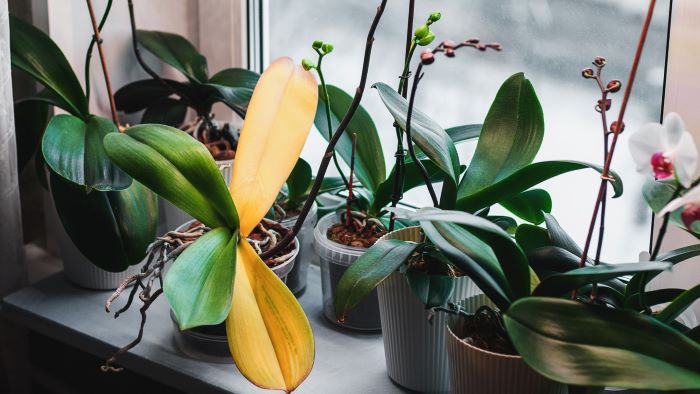Plants need water, sunlight, nutrients, and air to survive. But sometimes, even with the best care, plants can develop problems that affect their health and appearance. One of the most common signs of plant distress is yellowing leaves. Why do plant leaves turn yellow? What causes this condition? How to fix yellow leaves on plants?
Well, don’t worry, we have answers to all your questions. On behalf of you, we have done some great footwork and gathered information, which will give you a clear view.
We will explore the possible reasons for yellow leaves on plants, and also jotted down some tips on how to restore your plants to their green glory. So, whether you have a garden, a balcony, or a windowsill, you will find this information useful and interesting.
Read on to learn more about why plant leaves turn yellow and what you can do about it.
Contents
6 Reasons Plant Leaves Turn Yellow!
Many factors can affect the health and appearance of your plants, but here are some of the most common ones that cause yellow leaves:
1. Overwatering
Overwatering is one of the most common causes of plant leaves turning yellow. When you overwater your plants, you are essentially drowning them and depriving them of oxygen. As excess water also causes the roots to rot and makes the plants more susceptible to fungal diseases. Some signs of overwatering are:
- Soil is constantly wet and soggy
- Leaves are yellow, wilted, or droopy
- Falling off leaves easily or developing brown spots
- Your plant may have a foul smell or attract pests

After knowing the causes, it’s time to get some knowledge regarding prevention tips for overwatering.
- You need to check the soil moisture before watering your plants. It is advisable to water when the top inch of the soil feels dry to the touch.
- Water your plants deeply but infrequently, and avoid splashing water on the leaves.
- Always choose the right potting mix and fertilizer for your plants. This is because some plants prefer well-drained soil and low-nutrient fertilizer, while others need more moisture and nutrients.
Overwatering can be a serious problem for your plants, but it can be easily fixed if you catch it early.🌱💦
2. Plant Leaves Turn Yellow Due to Cold Stress
As we have an idea, cold stress is when plants get too cold and they cannot grow well. It makes the plants slow down their activities, lose water and sugar, break down their proteins, and have problems with their hormones. All these changes make the plants sick and weak, and they start showing signs. Such as smaller leaves, drooping, yellowing, and dying.
We recommend you move your plant indoors or to a warmer spot during winter or frosty nights. Plus, you can also cover them with a cloth or a plastic sheet to insulate them from the cold.
3. Dehydration
Wondering how dehydration can be the cause of plant leaves turning yellow? Let me explain to you.
When plants do not receive enough water, they are unable to take up essential nutrients from the soil. This leads to a deficiency of nitrogen, iron, magnesium, or other minerals, which are vital for the plant’s health and growth. As a result, the leaves lose their green color and turn yellow, especially around the edges and tips.

So, to prevent dehydration, you need to improve the drainage of your soil by adding perlite, sand, or compost. This will help you to prevent waterlogging and allow excess water to drain away. Furthermore, you can also mulch your plants with organic materials such as straw, bark, or leaves. This will help retain moisture in the soil and reduce evaporation.
Dehydration is a serious issue, which can affect the health of your plants. So, by watering your plants properly and regularly, you can prevent yellowing leaves and keep your plants happy and healthy.
4. Not Getting Proper Sunlight
Not getting proper sunlight is another common reason why plant leaves turn yellow-green. As sunlight is essential for plants to produce chlorophyll, the green pigment, which gives plants their color and allows them to perform photosynthesis. So, without enough sunlight, plants cannot make enough chlorophyll, and their leaves become pale, yellow, or yellowish-white.
But, don’t worry, you can fix this problem easily. All you need to provide your plants with adequate light, which will help them to thrive. However, remember different plants have different light requirements, so you need to be careful.
For instance, some plants need full sun, meaning they need at least six hours of direct sunlight per day. On the other hand, some plants prefer partial sun or partial shade, meaning they need four to six hours of direct or indirect sunlight per day.
By providing your plants with proper sunlight, you can prevent yellowing leaves and improve their health and look.
5. Due to Nutrient Deficiencies
Well, it’s true, nutrient deficiencies are another possible reason behind your plant leaves turning yellow. Nutrients are substances that plants absorb from the soil or water through their roots. Such as nitrogen, phosphorus, potassium, calcium, magnesium, iron, and others. Each nutrient has a specific role in the plant’s metabolism, and a lack of any of them can cause various symptoms, including yellowing leaves.

To prevent nutrient deficiencies, you need to maintain a healthy soil or water quality for your plants. You can test your soil or water pH and nutrient levels using a kit or a meter. Additionally, you can rotate your crops or change your water source periodically to avoid nutrient depletion.
Read More: Fence to keep rabbits out of garden, Ways to keep squirrels out of garden; How to keep birds off porch?
6. Pests or Disease
Some common pests that can cause yellowing leaves are spider mites, aphids, whiteflies, mealybugs, scale insects, and thrips. These pests can suck the plant’s sap, which contains water and nutrients, and reduce the plant’s vigor and growth. Some of these pests can also transmit viral or bacterial diseases to the plant, which can cause yellow spots or streaks on the leaves.
To prevent this problem, you need to maintain a healthy environment for your plants. You can do this by:
- Sanitize your garden tools before and after using them on different plants.
- You can quarantine any new plants before introducing them to your garden.
- Provide adequate light, water, and nutrients for your plants.
- Monitor your plants regularly for any signs of pests or diseases.
Conclusion
We hope you enjoyed reading our blog; Why do plant leaves turn yellow?
Let’s quickly recall.
Yellowing leaves are a common problem, that can affect many types of plants, but they are not always a sign of doom. Sometimes, they are just a natural part of the plant’s life cycle or a response to environmental changes. Other times, they indicate a lack of water, nutrients, or sunlight, or an infection by pests or diseases. The key is to identify the cause of the yellowing and take the appropriate action to fix it.
By following the tips we shared, you can prevent or treat yellow leaves on your plants and keep them healthy and green.
Remember, plants are not only beautiful, but also beneficial for your well-being. They purify the air, reduce stress, and boost your mood.
So, take good care of your plants and they will take good care of you.
Happy Gardening!

Hello, I’m Rose Lehman, the content writer of cozynest. I have been a gardener for over 5 years, and I have a certificate in master gardening from the Oregon State University Extension Service. I enjoy writing about all aspects of gardening, from the basics to the advanced, and from the practical to the creative. I also love to explore different types of gardens, cultures, and styles, and share them with our readers. My goal is to inspire and inform our audience, and help them grow their own cozynest.

